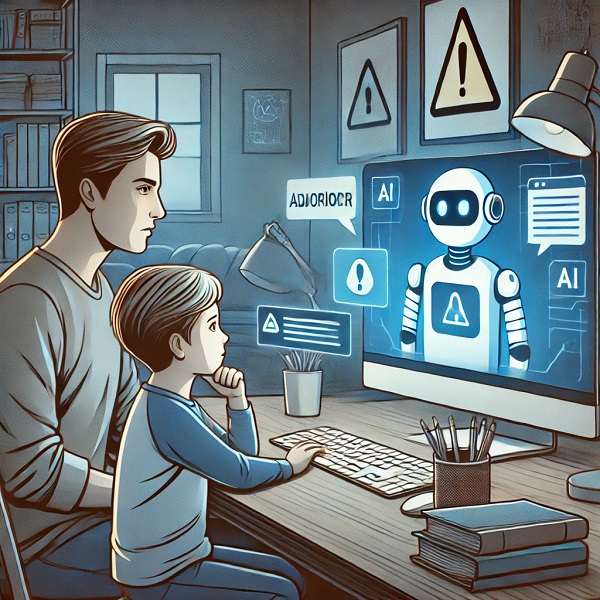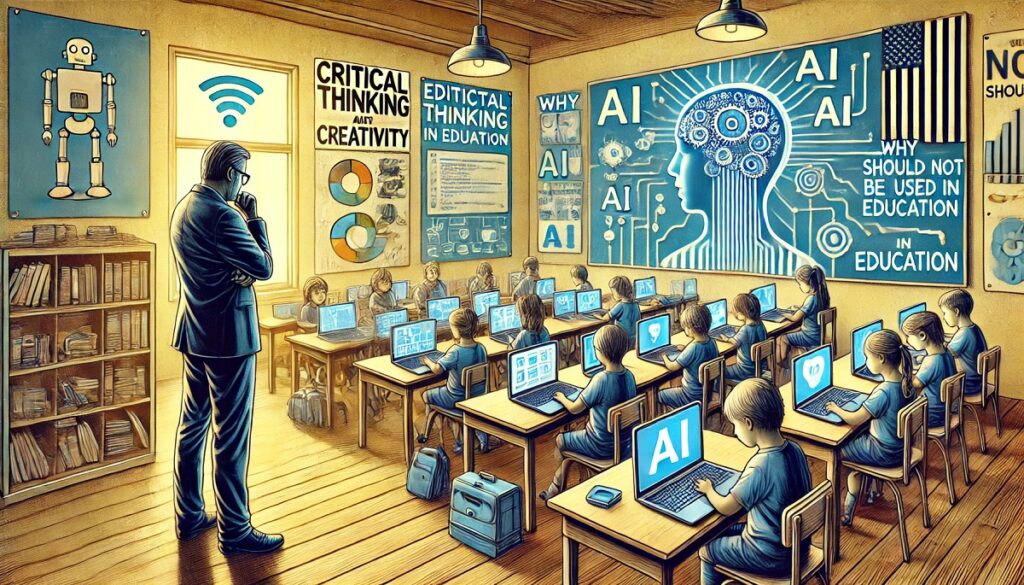In recent years, artificial intelligence (AI) has made significant strides, impacting various sectors, including education. While the promise of AI can be appealing, there are compelling reasons to reconsider its role in the classroom. Using AI in education can create several challenges. It may lead to less interaction between teachers and students, which is important for learning. Not all students have the same access to technology, making it harder for some to keep up. Additionally, there are concerns about privacy, bias, and students potentially cheating instead of truly understanding the material.This article delves into why AI should not be used in education, examining the negative effects of artificial intelligence in education, and offering insights for parents and teachers alike as they navigate parenting challenges in this digital age.
The Impact of AI in Teaching
Although innovative, integrating AI into education presents a number of difficulties, and AI should not be used in schools. The development of social skills and feelings of loneliness can result from less in-person interaction between educators and learners. Students’ critical thinking and problem-solving skills may suffer from an over-reliance on AI tools, particularly when there are technical outages. Extensive data collecting poses privacy hazards because it may be misused and personal data may be lost. AI systems with algorithmic biases may provide kids from different origins unequal access to resources and grades. Finally, if AI becomes more prevalent in education, teachers may lose their jobs as their vital contributions are undervalued.
Should AI Be Used in Schools: Pros and Cons
It’s critical to consider both the advantages and disadvantages of integrating AI into education. AI can facilitate individualized learning experiences by adjusting to the pace of each student, on the one hand. However, these advantages are accompanied by considerable hazards that should be carefully considered.
Pros of Using AI in Education
1. Personalized Learning:
AI is able to modify course materials to accommodate different learners’ preferences and rates of acquisition.
2. Efficiency:
By automating administrative duties, it allows teachers to devote more time to instruction.
3. Data-Driven Insights:
AI is able to examine student performance data and provide information on areas that require development.
Cons of AI in Education:
Why AI Should Not Be Used in Education: Parents May Be Concerned About a Number of Issues:
1. Loss of Personal Interaction:
We are concerned that AI may take the role of in-person interactions between educators and learners, which are crucial for fostering social skills and connections.
2. Issues with Equity and Access:
Not all kids have equal access to AI tools and technology, which can lead to unfair learning chances and a wider divide between pupils from diverse backgrounds
3. Dependency on Technology:
We are concerned that kids might grow unduly dependent on AI, which could impair their capacity for critical thought and problem-solving. They might not develop the ability to overcome obstacles on their own.
4: Privacy Issues
AI programs frequently gather a great deal of student data. As parents, we worry about our children’s safety and privacy because of how this information is utilized and who can access it.
5. Algorithmic Bias:
AI systems run the risk of reinforcing preconceptions in its programming, which could unfairly treat particular student groups and affect their educational experience.
6. Encouragement of Cheating:
Because AI technologies are so simple to use, there may be a culture of dishonesty where students finish tasks without fully comprehending the subject matter, which would undermine the educational process.
7. Absence of Emotional Support:
AI is unable to offer the same level of emotional support and direction as a human educator. We are concerned that kids can lose out on crucial opportunities for social and emotional development. How does AI negatively affect education? These issues show that incorporating AI into education requires a balanced strategy that improves learning without sacrificing moral principles or individual development.
Using AI as a Tool vs. Cheating
One important topic in the discussion of AI in education is the difference between cheating and using AI as a tool. Although artificial intelligence (AI) can help with research and provide explanations, there is a thin line between utilizing AI responsibly and depending on it for expediency.
1. Appropriate Use: Students can use AI for research support, teaching, and work evaluation. In a good learning environment, technology complements education rather than takes its place.
2. Cheating Risks: Conversely, students may exploit essays or answers produced by AI to get around learning. This conduct compromises their long-term knowledge and abilities in addition to their academic integrity.
The Dark Side of AI,Should Parents Be Concerned?

Not only in education, Artificial intelligence (AI) can be dangerous for children in several ways. It can spread fake information, help people trick others in online dating, and even create harmful content like AI-generated child sexual abuse material (CSAM). These technologies can make it easier for bad people to take advantage of kids.
The Craft Parents Guide
It can be difficult for parents to navigate the AI-shaped educational landscape. The goal of the Craft Parents Guide is to arm you with the information you need to make wise choices regarding artificial intelligence in education. Here are some crucial actions to think about:
Step 1: stay informed
It’s critical for parents to comprehend AI’s function in their children’s education. Keep abreast with the most recent developments in AI technologies, trends, and issues. Interact with other parents and educators, read articles, and go to workshops.
Step 2: Interact with Teachers
You can better understand how AI is being used in the classroom by keeping lines of communication open with your child’s teachers. Inquire about the resources they use, their advantages, and any possible disadvantages.
Step 3: Boost Critical Thinking
Encourage your kids to challenge the data that artificial intelligence (AI) systems provide them. Urge them to seek out a variety of information sources and use critical thinking. In a time where false information may travel quickly, this ability is extremely valuable.
Step 4: Keep an eye on internet activity
Keep a close eye on your child’s internet activity. Make sure they are not depending on AI to do their work without comprehending the ideas and are instead using it appropriately.
Step 5: Encourage Balanced Technology Use
Encourage a balanced approach to technology in education by interacting with other parents and school boards. Encourage projects that place equal emphasis on the application of AI and human interaction and critical thinking.
Conclusion, why AI should not be used in education
Even though AI offers fascinating educational opportunities, it is impossible to overlook the possible drawbacks. Recognizing artificial intelligence’s detrimental consequences in education and being aware of its negative aspects are essential to comprehending why ai should not be used in education. In conclusion, although the subject of whether AI should be employed in schools is one that merits investigation, the possible repercussions of its incorporation necessitate close examination. You can protect your child’s educational experience and make sure they flourish in a world where technology is having an increasing impact by following the instructions in the Craft Parents Guide.
Let’s use technology, but not at the price of our kids’ education and growth. We can achieve the ideal balance and guarantee a better future for the following generation if we band together.
1: What are the main concerns about using AI in education?
The main issues surrounding the use of AI in education are the possible drawbacks, which include an excessive dependence on technology, a decline in critical thinking abilities, and the potential for biased algorithms to influence learning results. Concerns regarding data security and privacy also exist because AI systems frequently gather and examine student data. It’s critical that schools and parents talk about these issues and put safety measures in place to reduce dangers.
2: How can parents ensure that AI is used responsibly in their children’s education?
By learning about the technology, talking openly with their kids about AI tools, and establishing clear rules for their use, parents can guarantee the appropriate use of AI in the classroom. To reduce the possibility of utilizing AI as a tool rather than cheating, parents should also push for schools to be transparent about the AI technologies they use and foster critical thinking in their kids.
3: What steps can be taken to balance the benefits and drawbacks of AI in education?
Parents and educators can:
1. Promote Critical Thinking: Encourage conversations regarding the data gathered from AI tools and teach kids to double-check facts in order to balance the advantages and disadvantages of AI in education.
2. Encourage Human Interaction: Place a strong emphasis on group projects and in-person instruction.
3. Establish Boundaries: Make sure that students don’t rely entirely on artificial intelligence (AI) for their tasks by establishing guidelines for technology use.
We can maximize AI’s benefits while reducing any potential downsides by taking a balanced approach.





